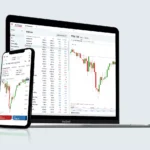Welcome to the exciting world of trading! Whether you’ve heard about the potential of trading to grow your finances or you’re simply curious, this guide will walk you through everything you need to know to get started. Trading can be an effective way to build wealth, but it requires knowledge, practice, and discipline. This guide will introduce you to the essential concepts, strategies, and tools to begin your trading journey confidently.
Let’s dive in!
What is Trading?
Trading is the act of buying and selling financial assets, such as stocks, forex (foreign exchange), cryptocurrencies, and commodities, to make a profit. Unlike long-term investing, which involves holding assets over several years, trading often focuses on shorter timeframes to capture quick price movements.
Understanding trading’s basics will help you make informed decisions as you explore different types of markets and opportunities.
Why Start Trading?
Before you begin, it’s essential to know why trading may be beneficial for you:
- Potential for Profit: Trading allows you to potentially earn profits by predicting price movements.
- Flexible Timeframes: You can trade for a few minutes, hours, days, or weeks, depending on your preference.
- Accessible Markets: With online trading platforms, anyone can trade from the comfort of their home.
Now, let’s explore what you need to get started!
Basic Requirements to Start Trading
When it comes to how to get started trading, there are a few essentials you’ll need:
- Trading Platform or Broker
- Choose a reputable online platform or broker where you can trade. Look for user-friendly platforms, reasonable fees, and access to customer support. Beginners often prefer platforms with intuitive designs, educational resources, and demo accounts.
- Internet Connection
- Trading requires a reliable internet connection to execute trades and access real-time market data without delays.
- Starting Capital
- Begin with a small amount to practice and gain experience. The exact amount will depend on the type of trading (e.g., stocks, forex) and your personal financial situation.
- Education and Resources
- Equip yourself with resources, such as beginner guides, courses, and tutorials on trading strategies and market analysis. The more you learn, the more confident you’ll feel in making decisions.
Types of Trading: Finding What Suits You Best
Let’s discuss some common types of trading styles to help you decide which one might suit your goals, risk tolerance, and available time.
Day Trading
- Definition: Day trading involves buying and selling assets within the same trading day to take advantage of small price movements.
- Pros: Fast-paced, potential for daily profits.
- Cons: Requires focus and a good understanding of the markets.
Swing Trading
- Definition: Swing trading involves holding assets for a few days to several weeks, aiming to capture short-term trends.
- Pros: Less time-intensive than day trading, allows flexibility.
- Cons: Requires patience and strong technical analysis skills.
Position Trading
- Definition: Position trading is a longer-term style, where traders hold assets for weeks, months, or even years.
- Pros: Ideal for those who prefer longer investment horizons.
- Cons: Requires knowledge of market fundamentals and the ability to wait through short-term volatility.
Scalping
- Definition: Scalping involves making many small trades within minutes to profit from tiny price changes.
- Pros: Quick gains if done correctly, high potential for small profits.
- Cons: High-stress, requires speed, precision, and attention to detail.
Each trading style offers unique advantages and challenges. Consider experimenting with different types to see what fits your personality and lifestyle.
How to Start: Setting Up for Your First Trade
Step 1: Choose a Reliable Broker or Trading Platform
- A trading platform is your gateway to the market. Look for a platform that suits beginners, offers demo accounts, and has educational resources. Some popular brokers for beginners include platforms like eToro, TD Ameritrade, and Webull.
Step 2: Open a Demo Account
- Many brokers offer demo accounts, which allow you to practice trading without real money. This is a risk-free way to get comfortable with how trading works and test your strategies.
Step 3: Fund Your Account
- Once you’re confident in your trading skills, you can start with a small deposit to begin live trading. Remember, you should only trade with money you can afford to lose, especially as a beginner.
Step 4: Learn to Use Basic Trading Tools
- Familiarize yourself with basic tools like:
- Charts: These show asset price movements over time.
- Technical Indicators: Tools like moving averages, Relative Strength Index (RSI), and Bollinger Bands help analyze trends.
- Order Types: Practice using market orders, limit orders, and stop-loss orders.
Essential Skills for Beginner Traders
Now that you’re set up, let’s look at the core skills you’ll need to become a successful trader.
1. Technical Analysis Basics
Technical analysis involves studying historical price patterns to predict future movements. Some foundational elements include:
- Reading Charts: Start with candlestick charts, as they provide detailed insights into price movements.
- Using Indicators: Moving averages help smooth out price data, while RSI shows overbought or oversold conditions.
2. Fundamental Analysis Basics
Fundamental analysis looks at external factors that could affect asset prices. For example:
- Economic News: Announcements about interest rates, inflation, or job reports can impact markets.
- Company Earnings Reports: For stocks, earnings reports can influence the stock price.
3. Risk Management
Risk management is critical in trading, as it protects you from losing more than you can handle. Key risk management practices include:
- Setting Stop-Loss Orders: This automatically sells an asset at a set price to prevent significant losses.
- Position Sizing: Only invest a small portion of your capital in a single trade to limit risk.
Creating a Trading Plan: Your Roadmap to Success
A trading plan is a personalized set of guidelines to help you make consistent and well-thought-out trades. Here’s what to include:
- Set Clear Goals
- Are you aiming for short-term gains or building wealth over time? Define your goals to choose the best trading style and strategies.
- Establish a Risk-Reward Ratio
- Decide how much risk you’re willing to take on each trade. For instance, some traders use a 1:2 risk-reward ratio, where they aim for gains twice the size of any potential loss.
- Define Entry and Exit Strategies
- Plan when to enter a trade (based on market conditions) and set clear points to exit (either to take profit or cut losses).
- Document Your Trades
- Keep a trading journal to track your decisions, outcomes, and lessons learned. This helps improve your trading skills over time.
Common Beginner Mistakes (and How to Avoid Them)
Trading can be challenging for beginners, so here are a few common pitfalls and tips to steer clear:
1. Overtrading
- Mistake: Making too many trades without a clear reason.
- Solution: Stick to your trading plan and avoid trading impulsively.
2. Ignoring Risk Management
- Mistake: Taking big risks without using stop-loss orders.
- Solution: Set stop-loss orders and keep trades within a manageable size.
3. Chasing “Hot Tips”
- Mistake: Following rumors or tips without research.
- Solution: Focus on reliable research and analysis instead of speculation.
4. Lack of Patience
- Mistake: Expecting instant success and fast profits.
- Solution: Understand that trading success comes with practice, patience, and time.
Start Small and Build Your Skills
It’s wise to start with a small trading account to minimize risk while you build confidence and experience. Focus on making consistent gains rather than aiming for big wins right away.
Continuous Learning is Key
Trading is a skill that requires ongoing learning. Consider reading trading books, taking online courses, and joining trading communities to exchange ideas and learn from others.
Conclusion: Take the First Step Towards Your Trading Journey
Trading offers great potential but requires commitment, patience, and a well-thought-out approach. With the guidance provided in this blog, you’re now equipped with the essential knowledge and tools to get started.
If you’re ready to embark on your trading journey, consider opening a demo account today to practice without risk. Remember, trading is a marathon, not a sprint. Focus on learning, practicing, and refining your strategies, and the results will follow.
Happy trading!



